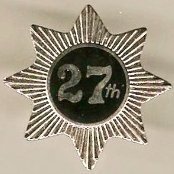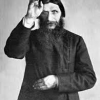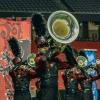Leaderboard
Popular Content
Showing content with the highest reputation on 10/30/2015 in all areas
-
5 points
-
Don't blame me. The DCI Corps agreed on the revised DCI scoring sheets. They ( including the Cadets ) made their own bed.. so they get to sleep in that bed. BD, since the beginning, has always figured out better than any other Corps, where the most build up points are to be had on any DCI Judging system that all the Corps decide on. They are the most adaptive and resilient Corps in the activity. BD was not always known for their great Guards. This was rarely their strongest section in their Corps. But they sure as heck are now. Thats because they understand the points to be had on the current DCI judging sheets, better than any other DCI Corps, imo. BD has had phenomenal Guards the last decade... and their staging with the Guards in the Visual realm, is where they tend to hit the ball right out of the park on the points to be most garnered on these current DCI scoring sheets, imo.2 points
-
PLEASE NO! As a software engineer, I still have nightmares about this failed Microsoft product.https://en.m.wikipedia.org/wiki/Microsoft_Bob1 point
-
You could always give it a little air of European Class and call it "Unglaubliche Trunkenheit."1 point
-
1 point
-
1 point
-
1 point
-
Perfectly stated. What's interesting is why it takes so long for other top WC to understand this. Cadets are a powerhouse but have had weak guards since around 2006. Bluecoats have also had unimpressive guards, certainly a few notches below their amazing brass n percussion lines. Crown has grasped this concept and have had pretty strong guards and last year they were just glorious. Should have won that caption but surely I digress.1 point
-
I still believe BK called their 2015 show "Because," uh, because they couldn't think of a theme to wrap around their program, and because "Here's a show with terrific music and mesmerizing drill, please enjoy it" was too long for Brandt Crocker to announce. While the show didn't have a theme, it did have cohesion. You don't always need the former to score well, but you do need the latter. BK showed this year that you don't need to give a cohesive program a name -- or at least a name that means anything.1 point
-
First let me defend these corps and their design teams. What they do isn't easy. The creative platform we know as drum & bugle corps is a combination of music, movement, color, dance, play acting, and more. Design teams are always trying to generate ideas, new ideas, often something refreshing or innovative. Things often look good on paper, but putting ideas on the field is truly demanding. I applaud those efforts, even when the show doesn't sparkle, perhaps loses it's connection from paper to performance and its' communication with the audience. The Blue Devils, masters of the judging sheets, haven't always connected with the crowd, and have won a few titles with shows that left many scratching their head. Now I loved this past summer's show, and I also loved 2014. 2012 and 2013 are forgettable for me. So if the correlation we're trying to draw is that more meaning = winning...well, I'm not so sure. Go back and watch drum corps from the late 70s and early 80s. Many shows didn't have a theme. The corps would play three or four fun charts to a fantastic visual program and people would LOVE it. Corps would stop and play concert numbers (standing still) and people would love it. Yes, shows are judged differently today, and the styles have changed; but entertainment is still the key, whether the theme be light and funny, dark, a deep storyline, a simple idea, or whatever. If you have a great story, like Phantom's 2008 production of Spartacus, then fantastic! If you can simply play four tunes and tie them into a show with fantastic visuals, much like The Cadets "Juxtaposition" show from 2001, then great. In 2003 the Cadets played throwback songs from bygone years -- Fanfare and Allegro [sCV], Malagena [Madison], and Rocky Point Holiday [Garfield]. The show had no theme that I could see other than a corps playing music from past years, two of which were made famous by other corps. They took 3rd place. Pretty good! The main thing is this: you have to make it work. In regard to Cadets 2015, they made the show work and placed top 4. Now, was it as effective as they would have liked? Probably not. The Blue Devils themselves had to tweak their 2015 show (Ink) a lot all the way up to Finals to make it work. Crown had to redo their ending and other sections to make it work, and it mostly did. Many still question the Dies Irae section and whether those changes were good or not. The Bluecoats in 2014 and 2015 came out with shows that I thought were HOME RUNS from the onset of the season. Tilt was just brilliant with almost no design flaws if you ask me. Kinetic Noise was the most modern show I've seen and I even liked the first ending better than the final ending. Tilt was a simple idea about movement that was weaved into powerful music and color. Kinetic Noise was more conceptual, with minimalist music driving visual ideas about sound, sound shaping, clusters, echoes, and using movement to shape those tonal ideas. Judges are NOT looking for themes, or deep meaning, or certain types of shows. That would be unfair. Judges only care that whatever you do, you do it well and sell it.1 point
-
Troopers' center snare of the past 5 years could have walked into any DCI snare line anywhere. Instead, he chose to age out with Troop and help build the corps. He's a talented and level-headed young man, and has my endless respect.1 point
-
So did I...but the fact they were available there was not well publicized. I wouldn't have known about it myself if I hadn't already been in line for next year's tickets.1 point
-
don't recall having to hike around to the box office to get Alumni Show tix this year, IIRC, got them when I got next yrs tix right there on the concourse1 point
-
I love a good guard, but the 2015 Cadets took high brass and were 3 hundredths of a point from high percussion as well, and their drill was beast (although not perfectly clean). In my simple mind, this should not translate to a 4th place overall result; especially when the musical elements are so strong. Contrast with 2014, where guard was second and drums were 4th, and the Cadets just missed holding onto Silver at Finals.1 point
-
Many of the Alumni corps originally re-formed for a "one more time" gig, big parade or local celebration of sorts, kind of like when 27th Lancers got back together to do the DCI championship performance in Foxboro back in '94. A portion of those "one more time" folks decided that they wanted a "few more times" and kept them going, but I think after a few years the slate of performances, parades, and especially rehearsals starting wearing on the older bodies and life and families got in the way. People got it out of their systems and went back into fan only mode. I know some of the members of Light Brigade expressed as much when they made their decision to disband several years ago. Even with corps that have "active" feeder units, the Alumni units are "local" and the marching members of the "feeders" may not be...case in point, Boston Crusaders-how many current members of the DCI Crusaders hail from the greater Boston area? My guess is a VERY small minority. I think one of the things that certainly didn't help the shrinking attendance at the Alumni Spectacular is the fact that a couple years ago, DCA stopped including that event in their ticket packages...now, those who attend have to make a decision as to whether to purchase a ticket and attend, rather than "we paid for it anyway, we might as well go". Inclement weather will REALLY leave a lot of empty seats, fortunately that hasn't been an issue YET. Having to hike half way around the stadium to get to the box office from the parking area, especially for a target audience that is not getting any younger and has mobility issues to begin with, certainly doesn't help matters any.1 point
-
I will say this ahginn. ahh did not have surfing relations with that women... not one tarm.1 point
-
(From a recent message sent to me.) (11 years ago) PermalinkRaw Message Report DCN by "Scotty" Chappell The other day I received a copy of the Drum Corps News which contained an extensive coverage of the Hall of Fame awards. It was indeed a pleasure for me to meet old friends and bat the breeze with those greats of yesteryear. Somehow the years seemed to fall away, the spirit and zest of those years of competition prevailed. Your editorial kindled me a desire to again don a uniform and be part of the scene, but, Alas! - the spirit is willing, but the flesh is weak. It occurred to me that you might like to receive a chronology of drum corps from within my active years, teaching, dating from 1929, at which time, you will see from the enclosure, the bugle began to grow up. At the risk of being vain glorious, I am mailing you that chronology. You have my permission to print it. Your kind words in that editorial I appreciate and I hope that my contact with you will not end with this communication. Yours in Drum Corps, "Scotty" Arthur F. Chappell Lexington, KY *The Evolution Of Drum Corps In The United States* When I look back to the year 1916, the year in which I first joined a drum corps, it doesn't seem possible that the simple military drum corps - marching in column of squads, playing a simple bugle pitched in "G" or "B" flat - could have developed into the drum corps of today: a drum corps that maneuvers in intricate and complex patterns bathed in an extravaganza of color; with flags, silks, guideons and other accoutrements, with resplendent uniforms reminiscent of earlier days; not to mention the plethora of musical instruments, from so-called subcontra to obligato, in "G-D" or "G-F"; plus drums of every shape, size, color and material, on which you will hear played "Strube," "Swiss," "French" and other rudiments that defy at least my comprehension. The drum corps in which I played in 1916, used "B" flat bugles, supplemented with "F" - crooks which allowed the bugle section to play in the diatronic as opposed to the standard harmonic series of the valveless bugle. I started to teach drum corps in 1929, a small drum corps located in Avon, Massachusetts, which was to enjoy the distinction of being the first drum corps in the United States to play music using the diatronic scale. The way that came about was as follows. Having gone through the experience of playing in the diatronic, using the "B" flat bugle with the "F" crook, it was only natural that I should look for a "D" crook to supplement the "G" bugle; but, I ran into a problem. The music stores did not stock the "D" crook . What was even worse, they had never heard of them. The only recourse was to build them myself. I purchased some copper tubing, some sleeves and some nipples and - - Presto! we were in business. To keep things in chronological order, I have to digress for a moment to tell a story of how the piston bugle came into being. A friend of mine, a Capt. Dallahan, was running for commander of the Canton, MA, American Legion. He had asked me if the Avon drum corps would serenade him down the street past the American Legion quarters. The corps agreed to do it. I should add at this time that we were being quite secretive about our new music. We planned to come out at the beginning of the oncoming season with this new departure. However, I had told the drum corps that we would use the new routine for the occasion. Capt. Dallahan hadn't told me that he also had invited the state champions in class B, so I told the corps that we would play the old routine, music without crooks. The corps was very disappointed. The members wanted to show off their new music. Well, the upshoot of it all was that I relented. So, down the street we went, playing the new music. The effect was immediate and electric. The director of the Rockland, Massachusetts, drum corps came racing down the street to investigate the phenomenon. By the way, his name was "Go Walls." He was with the school system in Rockland and he besieged me with such questions as What are those gadgets?" "Where can we buy them?" etc., etc., and, of course, the answer was, "You will have to make them yourself!" I found out later that he took the problem to Bill Ludwig, the man from whom he bought their instruments, and Bill came up with a rotary which later was changed to the piston, because it was considered unmilitary to hold the bugle with two hands. My point in telling this story is that it sets the date for the introduction of the valve, the outgrowth of the "D" crook, late 1929 or early 1930, I am not quite sure which. It was quite apparent that the adoption of the piston bugle was just a matter of time. American Legion however, was slow to embrace the free use of the valve. I insisted that the valve be taped in the "D" position which, of course, was rather shortsighted. I, on the other hand, chose to be a nonconformist in that I advocated the free use of the valve and, what was more important, the use of the tuning slide to obtain the facility of the chromatic. At this point, the year was 1946, another story starts to unfold. We in Norman Prince had an exceptional group of men. One of the baritone buglers, Jack Chisholm, got tired of pulling the slide. He went to Col. Jimmie Lynch who at that time was part owner of the Conn outlet in Boston, and asked him if he could make up a rotary to take the place of pulling the slide. Jim said that he could, and promptly had one made up in the instrument repair shop. It must be quite evident by this time that these efforts of Norman Prince and me had pointed drum corps in the direction of the path that eventually would be the criterion. I am proud of the part that Norman Prince and I had to play in the advancement of drum corps. Mention should be made relative to the role of the instrument manufacturers in the evolution of drum corps. Their foresight and initiative gave voicing to the bugle section beyond the wildest dreams of the arranger; and, of course, the array of drums available is fantastic. Last but not least, over the years many drill masters have labored to lift the maneuvering from the simple military to a point bordering the theatrical - the brilliant interweaving of the colors and standards throughout the routine on the field, not to mention the rifle and sabre manipulations, are a testimonial to the evolution of drum corps. It is hard to believe that the corps can improve, but time has a habit of doing the impossible. Arthur F. Chappell1 point
-
The Southern Knights Drum and Bugle Corps from Birmingham, Alabama will hold an Open House/Membership weekend on November 7th&8th and again on December 5th&6th at Leeds High School in Leeds, Alabama. The goal is to field a competitive corps in summer of 2016. The corps formed in January of 2015, and performed as a standstill group this past summer. We have 52, 3 valve G horns looking for players.... 9 snare, 4 tenor, 5 bass just waiting to be percussive... This equipment is looking for a performing partner for the summer of 2016. Come join the "The Quest" John Hoekstra Executive Director www.southernknightscorps.org facebook: southernknights11 point
-
Yes I noticed in 1988 or so the young people in corps decided that they didn't have to listen to staff members and would challenge everything! Gone were the days of "do as I say!"1 point
-
Everyone's memory is subjective, and colored by their own experiences. I had the honor to know Scotty Chapelle pretty well. I judged with him for a while in the late 60s-early 70s. We had many conversations about the direction drum corps was heading. As a musician, he was quite pleased with the continuous improvement of the brass sections. And, like many brass men, he wished that the percussion side could be minimized, in the manner of a symphony orchestra. Since I was a drummer, we enjoyed a difference of opinion. He also recognized that the corps were all made up of ordinary kids who did the best they could. I'm sure he would marvel at today.s brass work. He was a wonderful guy, a living legend in the Boston area. But I believe he would be appalled to learn that the number of corps still in existence is so small. We had more corps in the Boston area in 1972, most of whom owed Scotty some percentage of their existence, than currently exist in the entire world. While he always strove for polish and professionalism, he also knew that making a musical experience available to the widest possible number of kids was what he had worked toward all his life. The current exclusivity has been the biggest failure of the DCI era. If that hadn't been their goal from the beginning it should have been.1 point
-
I always thought it would be interesting to have one of the great hornlines from today try to play on those primitive horns to see what kind of sound they could produce.1 point
-
Yes... and Florida is one of the few remaining states that has no State Income Tax.. also good for retirees that draw income from other than Pensions, Social Security.1 point
-
The Trop is the worst acoustic environment I've ever experienced. Rather would drive across the state for a show than go to the Trop.1 point
-
Florida Wave, Geneseo Knights, Tarheel Sun, L'Insolite, Ventures, Valley Fever, Argonauts.1 point
This leaderboard is set to Chicago/GMT-05:00













